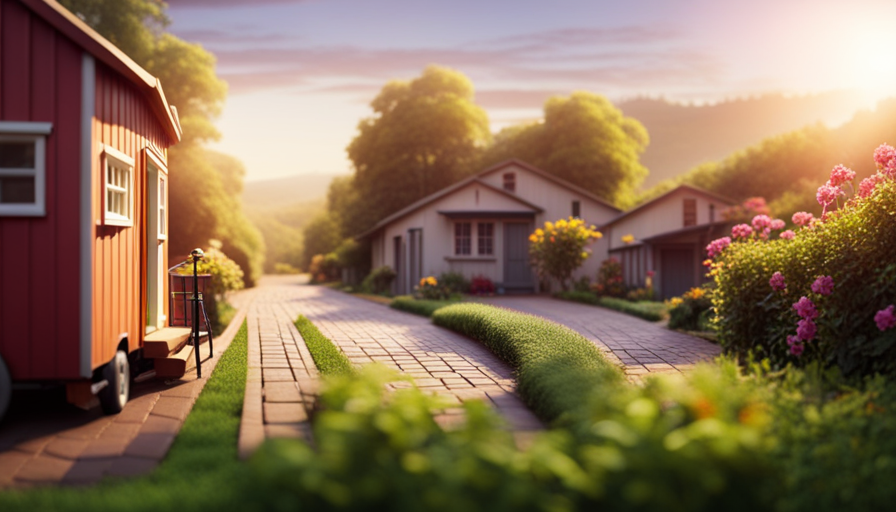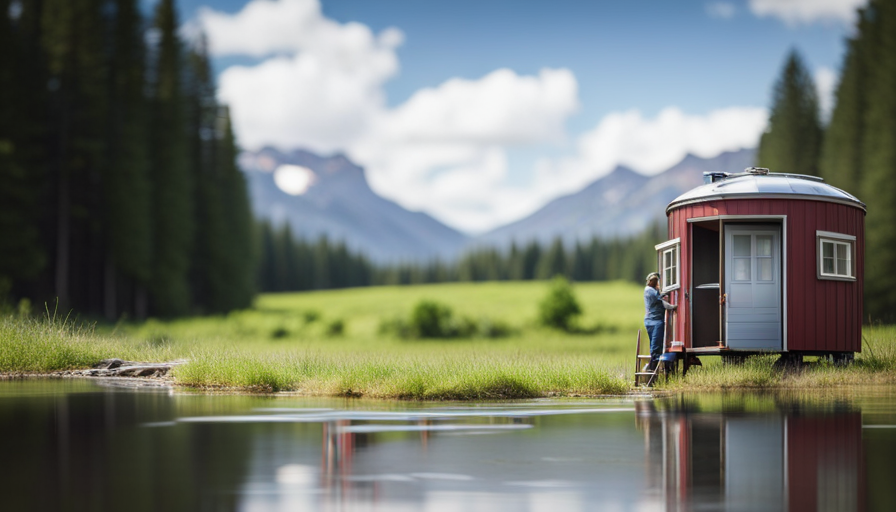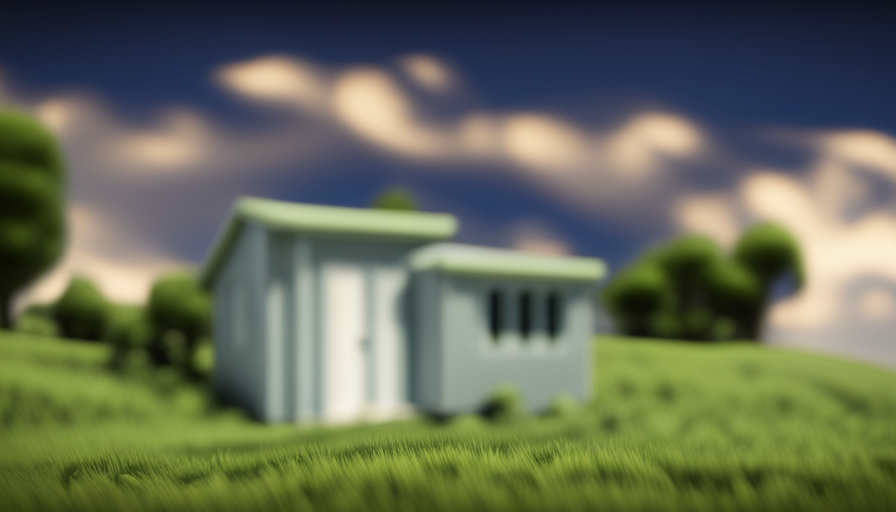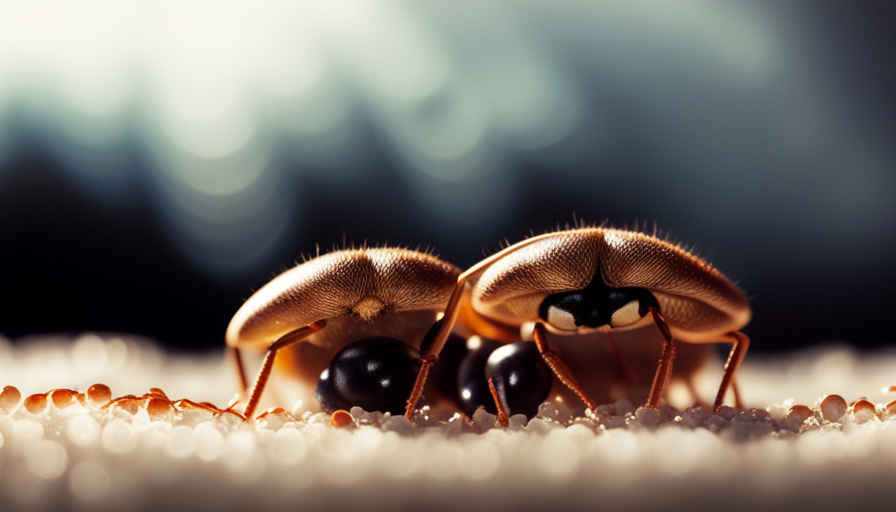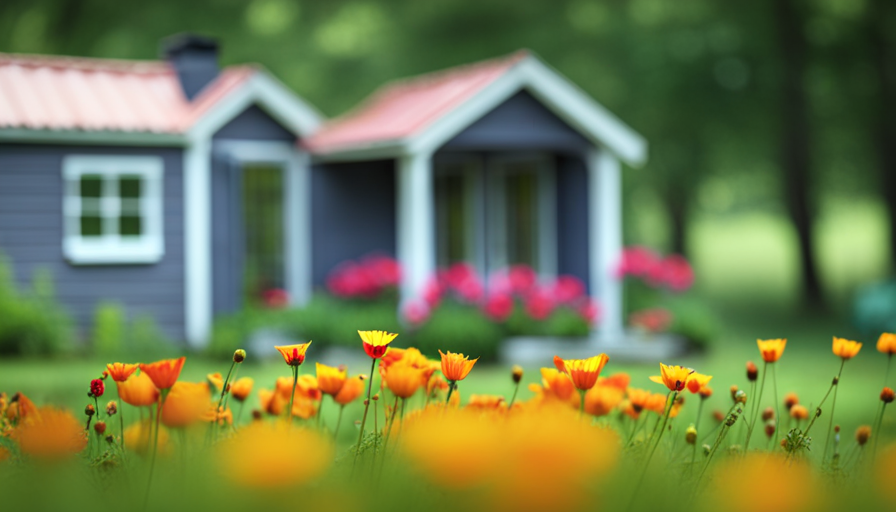Are you ready to join the tiny house movement? Get ready, because I’m here to help you navigate the process of buying a tiny house.
Now, I know what you’re thinking – how hard can it be to buy a tiny house? It’s just a small, compact living space, right? Wrong! Buying a tiny house is no small feat (pun intended). But fear not, for I am here to guide you through the process with the utmost expertise and flair.
From determining your budget and financing options, to researching different types and styles of tiny houses, to finding reputable builders or sellers, we’ve got it all covered.
So grab your magnifying glass and get ready to embark on the adventure of a lifetime – the journey to buying your very own tiny house.
Let’s dive in!
Key Takeaways
- Determine your budget and financing options
- Research different types and styles of tiny houses
- Find reputable builders or sellers through online research and recommendations
- Consider location and zoning regulations before placing your tiny house
Determine your budget and financing options
Figuring out your budget and exploring financing options can make your tiny house dream feel within reach, allowing excitement to overflow. Determining financing options is an essential step in the process of buying a tiny house. There are various ways to finance your tiny house, such as personal savings, loans, or crowdfunding. It’s crucial to calculate potential costs before making any decisions.
Consider the cost of the tiny house itself, along with any customization or modifications you may want to make. Additionally, factor in expenses like land, utilities, permits, and maintenance. Evaluating your financial situation and determining a realistic budget will help you narrow down your options and make informed choices.
Researching different types and styles of tiny houses will further enhance your understanding of what’s possible within your budget. Take the time to explore various designs, layouts, and materials used in building tiny houses. Consider the size, functionality, and aesthetic appeal that align with your preferences and lifestyle. Understanding your options will help you make an educated decision when it comes to purchasing your tiny house.
By carefully considering your financing options and calculating potential costs, you can confidently move forward in the process of buying a tiny house. Researching different types and styles of tiny houses will provide you with valuable insights as you navigate this exciting journey.
Research different types and styles of tiny houses
Exploring a variety of small-scale dwellings allows for a broader understanding of the diverse designs and aesthetics available in the realm of tiny homes. When researching different types and styles of tiny houses, it’s important to consider your preferences, needs, and budget.
There are various options to choose from, including traditional cottages, modern minimalist designs, rustic cabins, and even converted shipping containers. Each type offers its own unique features and benefits, so it’s crucial to explore them all to find the perfect fit for your lifestyle.
Additionally, while researching, it’s essential to keep your financing options in mind. Tiny houses can be a significant investment, and understanding how you’ll finance your purchase is crucial. Some options include personal savings, loans, or even crowdfunding. Researching different financing options will help you determine the most suitable approach for your situation.
Transitioning into the next section, deciding whether to buy a pre-built tiny house or build one yourself is the next step in the process. By exploring the various types and styles of tiny houses and understanding your financing options, you’ll be better equipped to make an informed decision about which route to take in acquiring your dream tiny home.
Decide whether to buy a pre-built tiny house or build one yourself
Consider whether purchasing a pre-built tiny house or embarking on the DIY route aligns better with your skills, preferences, and desired level of involvement in the construction process. Both options have their pros and cons, so it’s important to weigh them carefully before making a decision.
Pros and cons of buying a pre-built tiny house:nnPros: Pre-built tiny houses offer convenience and time-saving benefits. They’re ready to move into and often come with warranties. You can also tour model homes to get a better sense of the layout and design.
Cons: The cost of pre-built tiny houses can be higher compared to building your own. You might also have limited customization options, as they’re already constructed.
Benefits of building your own tiny house:nnYou have complete control over the design, layout, and materials used. This allows you to create a space that perfectly fits your needs and preferences. Building your own tiny house can be a fulfilling and rewarding experience. It gives you the opportunity to learn new skills and be directly involved in the construction process. You can save money by using reclaimed materials or opting for cost-effective alternatives. Building a tiny house from scratch allows for greater flexibility in terms of size and layout.
Considering the pros and cons of each option, you can now make an informed decision based on your skills, budget, and personal preferences.
In the subsequent section, we’ll explore how to find reputable builders or sellers for your tiny house.
Find reputable builders or sellers
When it comes to finding reputable builders or sellers, it’s important to research and connect with experienced professionals who can guide you through the process of acquiring your ideal tiny home.
Look for builders who have a strong reputation in the industry and a track record of delivering high-quality tiny houses. You want to ensure that the builder you choose is reliable and has a history of satisfied customers.
Start by searching online for reputable builders or sellers in your area. Read reviews and testimonials to get an idea of their workmanship and customer service. You can also ask for recommendations from friends, family, or fellow tiny house enthusiasts who have already gone through the process.
Once you have found a few potential builders or sellers, reach out to them and ask for more information. Discuss your specific needs and requirements, and see if they can accommodate you. It’s important to have open and honest communication with the builder or seller to ensure that they understand your vision and can deliver accordingly.
Transitioning into the subsequent section, visiting tiny house communities or attending tiny house festivals can provide you with valuable inspiration and ideas for your own tiny home.
Visit tiny house communities or attend tiny house festivals to gain inspiration and ideas
Immerse yourself in the vibrant atmosphere of tiny house festivals or communities, where you can connect with like-minded individuals and gain valuable inspiration for your dream home. Isn’t it exciting to imagine all the innovative designs and creative solutions you could discover?
Tiny house festivals and communities are a treasure trove of ideas and inspiration for those interested in the tiny house lifestyle. At these events, you can explore a variety of tiny house designs, from rustic cabins to modern minimalist structures. You can also learn about the latest tiny house design trends, such as space-saving furniture, multi-purpose rooms, and eco-friendly features.
Visiting tiny house communities allows you to see firsthand how people have embraced the benefits of living in a tiny house. You can witness the sense of community and connection that comes from living in close proximity to others who share the same values and aspirations. These communities often have shared spaces and amenities, such as gardens, workshops, and common rooms, which foster a strong sense of belonging.
As you explore these festivals and communities, take note of the design elements and features that resonate with you. Consider how you can incorporate these ideas into your own tiny house design. Once you have gathered inspiration, it’s time to move on to the next step: considering the location and zoning regulations for placing your tiny house.
Consider the location and zoning regulations for placing your tiny house
Once you’ve found the perfect spot for your tiny dream home, make sure to familiarize yourself with the local zoning regulations to ensure a smooth and legal placement.
It’s important to consider local housing laws and regulations before purchasing a tiny house, as they vary from place to place. Some areas may have restrictions on the size, type, or location of tiny houses, so it’s crucial to do your research beforehand.
Additionally, finding suitable land for your tiny house is another important consideration. Look for land that meets your needs in terms of size, accessibility, and amenities.
To navigate the process, reach out to local zoning offices or consult with a zoning attorney who can guide you through the specific regulations in your area. They can provide you with information on setbacks, utility connections, and any other requirements you need to meet.
It’s also a good idea to talk to neighbors or members of the community who have already placed tiny houses in the area, as they may have valuable insights and advice.
Once you have a clear understanding of the local regulations and have found suitable land, you can move forward with confidence in your tiny house journey. However, before making a purchase, it’s essential to perform inspections and due diligence to ensure the house meets your needs and is in good condition.
Perform inspections and due diligence before making a purchase
Before making a purchase, it’s important to thoroughly inspect and research the condition of the potential property to ensure it meets your needs and expectations. Performing inspections and due diligence is crucial in making an informed decision when buying a tiny house.
Start by hiring a professional home inspector who specializes in tiny houses. They’ll thoroughly examine the structure, plumbing, electrical systems, and any other important components.
Additionally, it’s essential to research the history of the property, including any previous owners, permits, or repairs. This will help you understand if there are any underlying issues or potential red flags.
While inspections provide crucial information, due diligence goes beyond that. It involves researching the area, neighborhood, and zoning regulations, ensuring that the tiny house is legally allowed in that location.
Moreover, check if there are any outstanding liens or encumbrances on the property that could affect your ownership. Take the time to review the neighborhood’s amenities, proximity to essential services, and any potential future developments that might impact your living experience.
By performing thorough inspections and due diligence, you can make an informed decision about purchasing a tiny house.
Now, let’s delve into the next step: negotiating the price and terms of the sale.
Negotiate the price and terms of the sale
To get the best deal on your dream tiny home, put your negotiation skills to work and make the price and terms of the sale work in your favor. When it comes to negotiating the price of a tiny house, it’s essential to do your research and understand the market value of similar properties. This knowledge will give you a strong foundation for negotiating a fair price.
Keep in mind that sellers may have emotional attachments to their tiny homes, so approaching the negotiation process tactfully is crucial.
Start by making an initial offer that’s lower than your maximum budget. This allows room for negotiation and gives you the opportunity to settle on a price that suits both parties. Be prepared to justify your offer by pointing out any flaws or necessary repairs that may affect the value of the tiny home.
In addition to the price, don’t overlook the importance of negotiating the sales terms. Consider factors such as the closing date, any contingencies, and the inclusion or exclusion of certain appliances or furnishings. These terms can significantly impact the overall value of the deal.
By effectively negotiating the price and terms of the sale, you can ensure that you’re getting the best possible deal on your dream tiny home. Once the negotiations are complete, it’s time to move on to securing financing or payment arrangements for your new abode.
Secure financing or payment arrangements
After negotiating the price and terms of the sale, the next step in buying a tiny house is to secure financing or payment arrangements. This is an important aspect of the process, as it’ll determine how you’ll be able to afford your new home.
There are several options available for securing financing for a tiny house. One option is to apply for a traditional mortgage, although this can be challenging as many lenders aren’t familiar with tiny homes. Another option is to seek out specialized lenders that focus on financing tiny houses. These lenders understand the unique nature of these homes and are more willing to provide loans.
Additionally, there are alternative payment options to consider, such as rent-to-own or lease-to-own agreements. These arrangements allow you to make monthly payments and eventually own the tiny house outright.
Whichever financing or payment option you choose, it’s important to carefully review the terms and conditions to ensure they align with your financial goals and capabilities.
With financing secured, the next step is to prepare for the logistics of moving and setting up your tiny house.
Prepare for the logistics of moving and setting up your tiny house
Now that you’ve secured financing or payment arrangements, it’s time to dive into the exciting logistics of moving and setting up your cozy abode on wheels. Moving a tiny house may seem challenging, but with careful planning and organization, it can be a smooth process.
Here’s a step-by-step guide to help you navigate through the moving logistics and setting up process:
-
Choose a suitable location: Before moving your tiny house, make sure you have a designated spot for it. Research local zoning laws and regulations to ensure that your tiny house is compliant with the area’s requirements.
-
Prepare your tiny house for the move: Secure all loose items inside your tiny house, such as furniture and appliances. Disconnect utilities and properly secure any external features, such as solar panels or awnings.
-
Find a reliable transportation method: Depending on the size and weight of your tiny house, you may need to hire a professional transportation company or rent a suitable truck or trailer. Make sure the transportation method is equipped to handle the weight and dimensions of your tiny house.
-
Set up your tiny house: Once you’ve reached your destination, it’s time to set up your tiny house. Install the necessary utilities, such as water, electricity, and sewage connections. Level your tiny house to ensure stability and functionality. Finally, personalize your space by arranging furniture, decorating, and making it feel like home.
Moving a tiny house requires careful planning and attention to detail, but with the right preparation, it can be a rewarding and fulfilling experience. Enjoy the process and embrace the freedom and flexibility that comes with living in a tiny house on wheels.
Frequently Asked Questions
What are the maintenance costs associated with owning a tiny house?
When it comes to owning a tiny house, it’s important to consider the maintenance costs. On average, these costs can range from $500 to $1,000 per year. Budgeting for these expenses is crucial to ensure the longevity and functionality of your tiny home.
Regular upkeep such as cleaning, repairs, and occasional renovations are necessary to keep your tiny house in top shape. By planning ahead and setting aside funds for maintenance, you can enjoy the benefits of tiny living without any unexpected financial burdens.
Are there any restrictions on living full-time in a tiny house?
Living restrictions and zoning regulations vary depending on the location and local laws. It’s important to research and understand the rules before committing to living full-time in a tiny house.
Some areas may have specific zoning requirements that restrict the use of tiny houses as primary residences. Additionally, some communities may have restrictions on the minimum square footage or the need for a permanent foundation.
Always check with local authorities to ensure compliance with regulations.
Can I customize the design and layout of a pre-built tiny house?
Yes, you can definitely customize the design and layout of a pre-built tiny house. While there may be some limitations depending on the specific pre-built model you choose, there are usually a variety of customization options available.
You can typically work with the manufacturer or builder to make changes to the interior layout, choose different finishes and materials, and even add personalized features. It’s important to communicate your preferences and discuss the customization options with the manufacturer before making a purchase.
Are there any hidden costs or fees when purchasing a tiny house?
When purchasing a tiny house, it’s important to be aware of any hidden costs or fees that may arise. These can include delivery charges, site preparation expenses, and utility hook-up fees.
It’s also crucial to consider financing options, such as loans or leases, to cover the cost of your tiny house. By thoroughly researching and understanding these potential costs, you can make a more informed decision and avoid any surprises down the road.
What are the insurance options for a tiny house?
When it comes to insurance coverage for a tiny house, there are a few options to consider. First, you’ll want to look into homeowner’s insurance, which can provide protection for your tiny house against damage or theft.
Additionally, there are specialized insurance policies specifically designed for tiny houses. These policies often offer coverage for liability, personal property, and even towing if needed.
It’s important to research and compare different insurance providers to find the best coverage for your tiny house financing needs.
Conclusion
So there you have it, my fellow tiny house enthusiasts. Buying a tiny house isn’t for the faint of heart, but with the right knowledge and preparation, it can be a rewarding and fulfilling endeavor. From determining your budget to researching different types and styles, to finding reputable builders and sellers, there’s a lot to consider.
But fear not, my friends, for the tiny house community’s a tight-knit and supportive one. So go forth, armed with this newfound knowledge, and embark on your tiny house adventure. May your dreams of minimalist living come true, and may your tiny house be a sanctuary of peace and tranquility.
Happy tiny house hunting!
Hi, I’m Emma. I’m the Editor in Chief of Tiny House 43, a blog all about tiny houses. While tree houses are often associated with childhood, they can be the perfect adult retreat. They offer a cozy space to relax and unwind, surrounded by nature. And since they’re typically built on stilts or raised platforms, they offer stunning views that traditional homes simply can’t match. If you’re looking for a unique and romantic getaway, a tree house tiny house might just be the perfect option.

